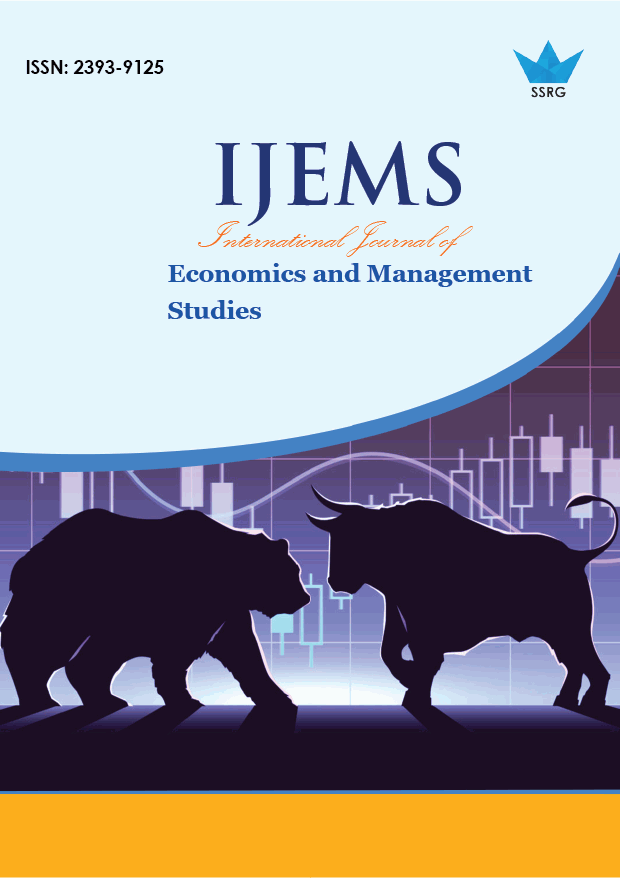Policy Interventions, Economic Shocks, and Financial Inclusion: Evidence from India’s PMJDY (2014–2025)

| International Journal of Economics and Management Studies |
| © 2025 by SSRG - IJEMS Journal |
| Volume 12 Issue 10 |
| Year of Publication : 2025 |
| Authors : Hridhaan Jain |
How to Cite?
Hridhaan Jain, "Policy Interventions, Economic Shocks, and Financial Inclusion: Evidence from India’s PMJDY (2014–2025)," SSRG International Journal of Economics and Management Studies, vol. 12, no. 10, pp. 32-41, 2025. Crossref, https://doi.org/10.14445/23939125/IJEMS-V12I10P105
Abstract:
One of the integral parts of inclusive growth in developing economies is financial inclusion. Our study examines the impact of certain policy interventions and economic shocks on the trends of financial inclusion in India. We utilize data from the Government of India’s Pradhan Mantri Jan Dhan Yojana (PMJDY) scheme. We perform Interrupted Time Series Analysis (ITSA) and CUSUM tests. The trends indicate a statistically significant change between 2014 and 2025. External shocks, such as demonetisation and Covid-19, as well as the start of the second phase of PMJDY, had a positive short-term impact on financial inclusion trends. This increased the number of beneficiaries, deposits, and debit cards (RuPay card).
Over Time, this upward trend has slowed down. The CUSUM test found another structural break in late 2015, which led to stability in the growth of the number of beneficiaries, deposits, and RuPay cards. These findings underscore the need for continuous and adaptable policy interventions to maintain progress in financial inclusion, ensuring that initial advantages translate into lasting, comprehensive access to financial services.
Keywords:
Accounts, COVID-19, Demonetisation, Deposits, Financial Inclusion, Interrupted Time Series Analysis, PMJDY.
References:
[1] Abhijit Banerjee, Esther Duflo, and Garima Sharma, “Long-Term Effects of the Targeting the Ultra Poor Program,” American Economic Review: Insights, vol. 3, no. 4, pp. 471–486, 2021.
[CrossRef] [Google Scholar] [Publisher Link]
[2] Dorothe Singer, and Asli Demirguc-Kunt, “Financial Inclusion and Inclusive Growth: A Review of Recent Empirical Evidence,” World Bank Policy Research Working Paper No. 8040, Washington, DC, 2017.
[Google Scholar] [Publisher Link]
[3] Mohammad Naim Azimi, “New Insights into the Impact of Financial Inclusion on Economic Growth: A Global Perspective,” PLOS One, vol. 17, no. 11, 2022.
[CrossRef] [Google Scholar] [Publisher Link]
[4] Shahzad Hussain et al., “Financial Inclusion and Economic Growth: Comparative Panel Evidence from Developed and Developing Asian Countries,” Sage Open, vol. 14, no. 1, 2024.
[CrossRef] [Google Scholar] [Publisher Link]
[5] Chuka et al., “Financial Inclusion and Its Impact on Economic Growth: Empirical Evidence from Sub-Saharan Africa,” Cogent Economics & Finance, vol. 10, no. 1, 2022.
[CrossRef] [Google Scholar] [Publisher Link]
[6] Nasir Khan et al., “Financial Inclusion as a Catalyst for Economic Growth: Evidence from Selected Developing Countries,” Cogent Social Sciences, vol. 10, no. 1, 2024.
[CrossRef] [Google Scholar] [Publisher Link]
[7] Peterson K. Ozili, Adekemi Ademiju, and Semia Rachid, “Impact of Financial Inclusion on Economic Growth: Review of Existing Literature and Directions for Future Research,” International Journal of Social Economics, vol. 50, no. 8, pp. 1105–1122, 2022.
[CrossRef] [Google Scholar] [Publisher Link]
[8] Cyn-Young Park, and Rogelio Mercado, “Financial Inclusion, Poverty, and Income Inequality,” The Singapore Economic Review, vol. 63, no. 1, pp. 185–206, 2017.
[CrossRef] [Google Scholar] [Publisher Link]
[9] Shreya Pal, Shravni Vankila, and Melvin Norbert Fernandes, “Interplay of Financial Inclusion and Economic Growth in Emerging Economies,” World Development Sustainability, vol. 6, 2025.
[CrossRef] [Google Scholar] [Publisher Link]
[10] E. Al. Moore et al., The Global Findex Database 2021, Financial Access, pp. 1-225, 2021. [Online]. Available: https://documents1.worldbank.org/curated/en/099818107072234182/pdf/IDU06a834fe908933040670a6560f44e3f4d35b7.pdf
[11] Pradhan Mantri Jan-Dhan Yojana, Department of Financial Services, Ministry of Finance. [Online]. Available: https://www.pmjdy.gov.in/
[12] Krupesh Thakar, and Kapil K. Dave, “A Study on the Performance of Pradhan Mantri Jan Dhan Yojana (PMJDY) in India,” Research Review International Journal of Multidisciplinary, vol. 10, no. 4, pp. 275-284, 2025.
[CrossRef] [Google Scholar] [Publisher Link]
[13] R. Ashwath, and G.R. Sachindra, “The Impact of Pradhan Mantri Jan Dhan Yojana on Financial Inclusion and Socio-economic Development in India,” International Journal of Finance and Commerce, vol. 7, no. 2, pp. 22-28, 2025.
[Publisher Link]
[14] Radheshyam Kalawat, Shivani Abrol, and Ritu Sapra, “Pradhan Mantri Jan Dhan Yojana: A Decade of Digital Transformation and Financial Inclusion,” International Journal of Management and Humanities, vol. 11, no. 9, 2025.
[CrossRef] [Google Scholar] [Publisher Link]
[15] Charan Singh, and Gopal Naik, “Financial Inclusion after PMJDY: A Case Study of Gubbi Taluk, Tumkur,” Working Paper No. 568, 2017.
[CrossRef] [Google Scholar] [Publisher Link]
[16] Vishal Yadav et al., “District-level Analysis: Impact of PMJDY in Augmenting Financial Inclusion in India,” MPRA Paper, 2020.
[Publisher Link]
[17] Sagnik Maity, and Amit Majumder, “A Nationide Comparative Study on Financial Inclusion through PMJDY,” Management Journal for Advanced Research, vol. 4, no. 3, pp. 10-21, 2024.
[CrossRef] [Google Scholar] [Publisher Link]
[18] Ajay Pal Singh, and Gagan Deep, “Unlocking Financial Inclusion: Indian Banks’ Efficiency in PMJDY Through DEA,” Rajagiri Management Journal, vol. 19, no. 1, pp. 2-17, 2025.
[CrossRef] [Google Scholar] [Publisher Link]
[19] Nidhi Gupta, and Mukesh Mathur, “India’s Financial Shape-up: PM Jan Dhan Yojana - Critical Review,” Research Hub International Multidisciplinary Research Journal, vol. 10, no. 7, pp. 48-56, 2023.
[CrossRef] [Publisher Link]
[20] Amartya Lahiri, “The Great Indian Demonetization,” Journal of Economic Perspectives, vol. 34, no. 1, pp. 55–74, 2020.
[CrossRef] [Google Scholar] [Publisher Link]
[21] M.K. Muhammed Shafi, and K.M. Sudheer Muhammed, “Impact of Demonetization on Financial Inclusion in India: A Study with Evidence of Emerging Digital Financial Services,” International Journal of Management, vol. 11, no. 12, pp. 2807-2819, 2019.
[CrossRef] [Google Scholar] [Publisher Link]
[22] Anchal Khandelwal, Abhishek Vajjala, and Anirudh Tagat, “Financial Literacy and Inclusion in India: Evidence from Household level Data After Demonetization,” Journal of Emerging Market Finance, 2025.
[Google Scholar]
[23] Bhanu Pratap Singh et al., “Financial Inclusion, Pradhan Mantri Jan-Dhan Yojna Scheme and Economic Growth: Evidence from Indian States,” Economic Notes Review of Banking, Finance and Monetary Economics, vol. 50, no. 3, 2021.
[CrossRef] [Google Scholar] [Publisher Link]
[24] Aastha Sinha, “Digital Technology Improving Financial Inclusion in India: Post Covid Evidence,” Asian Journal of Economics, Business and Accounting, vol. 24, no. 2, pp. 107-122, 2024.
[CrossRef] [Google Scholar] [Publisher Link]
[25] Shnehal Soni, and R.L. Manogna, “Financial Inclusion in India Amid Covid-19 Pandemic: Recent Trends and Determinants,” Journal of the Knowledge Economy, vol. 15, pp. 20699-20717, 2024.
[CrossRef] [Google Scholar] [Publisher Link]
[26] P.S. Meghana, and R. Supriya, “Impact of Covid-19 on the Performance of Pradhan Mantri Jan Dhan Yojana (PMJDY) accounts,” SSRN, 2023.
[CrossRef] [Google Scholar] [Publisher Link]
[27] Manohar Serrao, Aloysius Sequeira, and K.V.M. Varambally, “Impact of Financial Inclusion on the Socio-economic Status of Rural and Urban Households of Vulnerable Sections in Karnataka,” arXiv preprint, 2021.
[CrossRef] [Google Scholar] [Publisher Link]
[28] Shreya Biswas, “Effect of Mobile Financial Services on Financial Behavior in Developing Economics-Evidence from India,” arXiv preprint, 2021.
[CrossRef] [Google Scholar] [Publisher Link]
[29] Atul Sarma, “Demonetisation 2.0: Aims and Achievements,” Social Change and Development, vol. XIV, 2017.
[Google Scholar] [Publisher Link]
[30] Sumit Agarwal et al., “Demonetization and Digitization,” SSRN Electronic Journal, 2018.
[CrossRef] [Google Scholar] [Publisher Link]
[31] U. Divya, and Noor Firdoos Jahan, “A Study on Demonetization in India and Its Impact on Pradhan Manthri Jan Dhan Accounts,” ISBR Management Journal, vol. 5, no. 1, 2019.
[Google Scholar] [Publisher Link]
[32] Areendam Chanda, and C. Justin Cook, “Who Gained from India’s Demonetization? Insights from Satellites and Surveys,” Insights from Satellites and Surveys, 2019.
[Google Scholar] [Publisher Link]
[33] Himanshu, and Ritika, “Effect of Demonetization on PMJDY,” Research Directions, vol. 6, no. 8, 2019.
[Publisher Link]
[34] T.M. Dinesh, and Kiran Kumar Reddy, “Demonetization and Its Effects on Digital Payments,” Economic Affairs, vol. 63, no. 2, pp. 407-411, 2018.
[CrossRef] [Google Scholar]
[35] Aryaman Kedia, and Neharika Shrivastava, “Evaluating the Impact of Pradhan Mantri Jan Dhan Yojana (PMJDY) on the Indian Economy: A Paired Sample Analysis using Secondary Data,” International Journal of Social Science and Economic Research, vol. 10, no. 6, pp. 2184–2212, 2025.
[CrossRef] [Google Scholar] [Publisher Link]
[36] Press Information Bureau, From Cash to Digital: India’s Leap Towards Inclusive Finance, 2025. [Online]. Available: https://www.pib.gov.in/FactsheetDetails.aspx?id=149258&NoteId=149258&ModuleId=16
[37] India: National Mission for Financial Inclusion (Pradhan Mantri Jan-Dhan Yojana (PMJDY)) – Global Alliance Against Hunger and Poverty. [Online]. Available: https://globalallianceagainsthungerandpoverty.org/country-example/india-national-mission-for financial-inclusion-pradhan-mantri-jan-dhan-yojana-pmjdy/
[38] Insight IAS, Pradhan Mantri Jan Dhan Yojana: Eleven years of Financial Inclusion, InsightsonIndia, 2025. [Online]. Available: https://www.insightsonindia.com/2025/08/27/pradhan-mantri-jan-dhan-yojana-eleven-years-of-financial-inclusion/
[39] Vision IAS, Pradhan Mantri Jan Dhan Yojana: 11 Years of Banking the Unbanked, 2025. [Online]. Available: https://visionias.in/blog/current-affairs/pradhan-mantri-jan-dhan-yojana-11-years-of-banking-the-unbanked
[40] Amna Malik et al., Making the Case: India, Case Studies on Inclusive Economic Development, Centre for Inclusive Growth, 2022. [Online]. Available: https://centreforpublicimpact.org/wp-content/uploads/2024/12/mcg-22003r-pmjdy-india_v6.pdf
[41] Amin Kassoul, “The Positive Side of COVID−19 Pandemic− Boosting Financial Inclusion by Spurring the Remittance Flows and Digital Payments,” Academy of Strategic Management Journal, 2022.
[Google Scholar] [Publisher Link]

 10.14445/23939125/IJEMS-V12I10P105
10.14445/23939125/IJEMS-V12I10P105